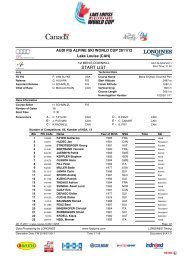You also want an ePaper? Increase the reach of your titles
YUMPU automatically turns print PDFs into web optimized ePapers that Google loves.
Photo:Archive ISR<br />
Why a 3S system?<br />
Professor Josef Nejez, ISR,<br />
explains the technical reasons<br />
for the choice of the 3S system<br />
for the Peak to Peak Gondola.<br />
In order to understand<br />
why<br />
the 3S system was<br />
found to be the<br />
optimum solution<br />
for linking two ski<br />
areas located on<br />
either side of a<br />
deep valley, we<br />
must first of all<br />
consider the basic<br />
Prof. Dr. Josef Nejez<br />
differences in<br />
terms of engineering and operation between<br />
the main types of aerial passenger ropeways<br />
on the market today.<br />
The main differences between modern<br />
ropeway systems concern the number of<br />
ropes employed and the mode of operation.<br />
With regard to the ropes, the basic distinction<br />
is between monocable and bicable configurations,<br />
and for the mode of operation<br />
between reversible (jigback) and continuously<br />
circulating systems.<br />
The ropes<br />
In the case of a monocable system, fixed or<br />
detachable grips are used to attach the carriers<br />
to a rope that provides support and traction<br />
at the same time. The rope employed<br />
on a monocable system is called the haul<br />
(or hauling) rope.<br />
On a bicable system, the carriers are suspended<br />
from a carriage that travels along a<br />
track rope and is pulled by a separate haul<br />
rope. In this case, carrier support and traction<br />
are distinct functions performed by<br />
two ropes of different construction. The<br />
track ropes take the form of full-locked coil<br />
ropes, which are highly compact on section<br />
and thus ideally suited to absorb shear loads<br />
(wheel loads from the carriages). The haul<br />
ropes are round strand Lang’s lay ropes,<br />
which have two key characteristics that fulllocked<br />
coil ropes do not: the flexibility<br />
needed to negotiate the rope sheaves and<br />
suitability for splicing so as to create an<br />
endless loop. The hauling rope on a monocable<br />
system must also meet that require-<br />
Photos:Whistler Blackcomb<br />
Although the haul rope is not yet in place<br />
here, the rope configuration for the<br />
3S system is clear.<br />
ment and the same rope construction is accordingly<br />
used as for the haul rope on a bicable<br />
system.<br />
There are other significant differences between<br />
full-locked coil ropes and round<br />
strand ropes which affect their potential uses<br />
in the field of ropeway engineering,<br />
namely the rope strength design factor, fill<br />
factor (share of the metallic section in the<br />
geometrical section of the rope) and rope<br />
surface. Compared with round strand<br />
ropes, the full-locked coil ropes used as<br />
track ropes can have a lower rope strength<br />
design factor, while the fill factor is higher<br />
and the rope surface is much smoother. The<br />
lower design factor and higher fill factor<br />
provide for longer spans, while the<br />
smoother surface provides a better track for<br />
the carriage wheels.<br />
So far we have only referred to one track<br />
rope and to one haul rope or hauling rope,<br />
meaning a rope that serves to provide support,<br />
traction or both support and traction.<br />
But each of these functions can be assigned<br />
to more than one rope. On big jigbacks,<br />
this is usually the case with regard to the<br />
support function; instead of just one track<br />
rope such installations are built with two<br />
parallel track ropes. Similarly, if the haul<br />
rope on a continuous loop system (gondola)<br />
is replaced by two parallel synchronized<br />
haul ropes with a gage that is wider than<br />
the width of the carrier, we have what is<br />
No need to be a tightrope walker for a highlevel<br />
walk on the 3S system!

















